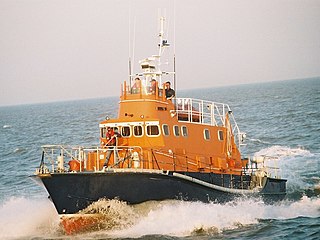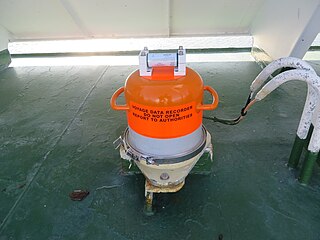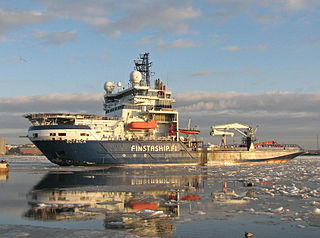
NS Savannah was the first nuclear-powered merchant ship. She was built in the late 1950s at a cost of $46.9 million and launched on July 21, 1959. She was funded by United States government agencies. Savannah was a demonstration project for the potential use of nuclear energy. The ship was named after SS Savannah, the first steamship to cross the Atlantic ocean. She was in service between 1962 and 1972 as one of only four nuclear-powered cargo ships ever built.

CCGS Terry Fox is a Canadian Coast Guard heavy icebreaker. She was originally built by Burrard-Yarrows Corporation in Canada in 1983 as part of an Arctic drilling system developed by BeauDril, the drilling subsidiary of Gulf Canada Resources. After the offshore oil exploration in the Beaufort Sea ended in the early 1990s, she was first leased and then sold to the Canadian Coast Guard.

LÉ Niamh (P52) is a Róisín-class offshore patrol vessel in the Irish Naval Service. The ship is named after Niamh, queen of Tír na nÓg, from Irish mythology. Commissioned in 2001, as of 2020 the ship was in active service.

LÉ Róisín (P51) is the lead ship of her class of offshore patrol vessel in the Irish Naval Service. Commissioned in 1999, the ship's primary mission is fisheries protection, search and rescue, and maritime protection operations, including vessel boardings. Róisín or Róisín Dubh, is often used as an allegory for Ireland. However the original Róisín Dubh was a daughter of Red Hugh O’Neill, Earl of Tyrone in the late 16th century.

The Arun-class lifeboat was a fast all-weather lifeboat designed by the Royal National Lifeboat Institution (RNLI) for service at its stations around the coasts of the United Kingdom and Ireland. They were operated by the RNLI between 1971 and 2008. Many have been sold to see further service in the lifeboat and coastguard services of other countries.

Voyage data recorder, or VDR, is a data recording system designed for all vessels required to comply with the IMO's International Convention SOLAS Requirements in order to collect data from various sensors on board the vessel. It then digitizes, compresses and stores this information in an externally mounted protective storage unit. The protective storage unit is a tamper-proof unit designed to withstand the extreme shock, impact, pressure and heat, which could be associated with a marine incident.

RV Western Flyer is a twin hulled SWATH research vessel operated by the Monterey Bay Aquarium Research Institute (MBARI). Its relatively stable SWATH design permits expanded operational capability in rough sea states. It is the platform of operations for the ROV Doc Ricketts. The vessel carries 10 crew, 5 ROV pilots, and 11 scientists, for a total complement of 26. Cruises generally center around the central California coast and Monterey Bay, although excursions further afield to Hawaii, the Pacific Northwest, and the Gulf of California have taken place in recent years.

The Pacific class is a class of 22 patrol boats built by Australia and donated to twelve South Pacific countries. They were constructed between 1985 and 1997 and are operated by militaries, coast guards or police forces of twelve island nations. These boats are supported by the Pacific Patrol Boat Program and used primarily for maritime surveillance and fisheries protection.

ARM Sonora (PO-152) is a Durango-class patrol vessel in service with the Mexican Navy with a 57 mm (2.2 in) main gun turret and a helicopter landing pad, primarily used for illicit drug interdiction. Like other ships of this class, it was designed and built in Mexican dockyards. The vessel was launched and commissioned on 4 September 2000 and is in active service.

The Hatsuharu-class destroyers were a class of Imperial Japanese Navy destroyers in the service before and during World War II. The final two vessels in the class, completed after modifications to the design, are sometimes considered a separate "Ariake class".
SCF Sakhalin is a Russian icebreaking platform supply and standby vessel owned by SCF Sakhalin Vessels Limited, a subsidiary of Sovcomflot. The ship was built by Aker Finnyards Helsinki shipyard in Finland in 2005 as FESCO Sakhalin for Far East Shipping Company (FESCO), but was purchased by Sovcomflot and renamed in 2010. Since the beginning it has been in long-term charter for Exxon Neftegas Ltd. and used to supply oil platforms in the Sakhalin-I project.

Seahorse Mercator is a navigational training vessel operated by Defence Maritime Services under contract to the Royal Australian Navy (RAN). She is a modified version of the Pacific-class patrol boat design and is based at HMAS Waterhen in Sydney.

MSV Botnica is a multipurpose offshore support vessel and icebreaker built by Finnyards in Rauma, Finland, in 1998. She was the newest and technically most advanced state-owned icebreaker of Finland until 2012, when she was sold to the Port of Tallinn for 50 million euro. Botnica is used as an escort icebreaker in the Baltic Sea during the winter months, but carries out subsea and offshore construction works worldwide during the open water season.
The BRP Simeon Castro (PC-374) is the fourth ship of the Jose Andrada class coastal patrol boats of the Philippine Navy. It is part of the first batch of its class ordered through US Foreign Military Sales (FMS) in 1989, and was commissioned with the Philippine Navy on 24 June 1991. It was initially designated as Fast Patrol Craft, and was numbered "DF-374", but later on was re-designated as a Patrol Gunboat, and was re-numbered as "PG-374", until another round of reclassification changed its designation as a Patrol Craft with hull number "PC-374" from April 2016.

Leschi, named for the native American leader Chief Leschi, is a fireboat operated by the Seattle Fire Department. The ship was laid down in 2006 and commissioned in 2007; its sponsor was Sharon Nickels, wife of the then-mayor Greg Nickels.

BRP Gabriela Silang (OPV-8301) is an offshore patrol vessel of the Philippine Coast Guard. She is the first offshore patrol vessel and currently, the second largest and most modern vessel of the Philippine Coast Guard. Named after Gabriela Silang, a revolutionary leader during the Philippine struggle for independence from Spain. She was constructed by French shipbuilder OCEA S.A. based on the OPV-270 Mk II design, in Les Sables-d'Olonne, France.

As a major port, there is a long history of fireboats in Singapore.

JS Nichinan (AGS-5105) is the only ship of her type of oceanographic research ship for the Japan Maritime Self-Defense Force.

JDSHayabusa(PC-308) was a submarine chaser of the Japan Maritime Self-Defense Force (JMSDF) in the mid-1950s. She was later converted to an accommodation ship and redesignated as ASY-91. She was the third vessel to inherit the name after the Imperial Japanese Navy's Hayabusa-class torpedo boat Hayabusa and Ōtori-class torpedo boat Hayabusa.
The Vsevolod Bobrov is an Elbrus-class logistics support vessel in the Russian Navy. Built by the Severnaya Verf Shipyard from 2013 to 2021, the ship is used for transporting dry cargo, water, and ammunition, as well as providing search-and-rescue, medical support, and towing capabilities. It was named after Soviet football and ice hockey player Vsevolod Bobrov.


















